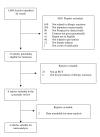The prevention of anaphylactoid reactions to iodinated radiological contrast media: a systematic review
- PMID: 16643668
- PMCID: PMC1475567
- DOI: 10.1186/1471-2342-6-2
The prevention of anaphylactoid reactions to iodinated radiological contrast media: a systematic review
Abstract
Background: Anaphylactoid reactions to iodinated contrast media are relatively common and potentially life threatening. Opinion is divided as to the utility of medications for preventing these reactions. We performed a systematic review to assess regimes for the prevention of anaphylactoid reactions to iodinated contrast media.
Methods: Searches for studies were conducted in the Medline, EMBASE, CINAHL and CENTRAL databases. Bibliographies of included studies and review articles were examined and experts were contacted. Randomised clinical trials that examined agents given prior to iodinated contrast material for the prevention of anaphylactoid reactions were included in the review. The validity of the included studies was examined using a component approach.
Results: Six studies met the inclusion criteria, but only one of these fulfilled all of the validity criteria. There were four studies that examined the use of H1 antihistamines, each was used to prevent anaphylactoid reactions to ionic contrast. The random effects pooled relative risk demonstrated a significant reduction in the overall rate of anaphylactoid reactions (RR = 0.4, 95% CI 0.18-0.9, p = 0.027). There were insufficient studies to produce a pooled statistic for the use of corticosteroids, however regimes of steroids (methylprednisolone 32 mg) given at least six hours and again two hours prior to the administration of contrast suggested a reduction in the incidence of anaphylactoid reactions.
Conclusion: In conclusion, there are few high quality randomised clinical trials that have addressed the question of the optimal methods to prevent allergic type reactions to iodinated radiological contrast media. Allowing for these limitations, the results suggest that H1 antihistamines given immediately prior to the administration of ionic contrast may be useful in preventing reactions to ionic contrast and are suggestive of a protective effect of corticosteroids when given in two doses at least six hours prior and again two hours prior to the administration of contrast, both ionic and non-ionic. These agents should be considered for use in patients who are at high risk of an anaphylactoid reaction to contrast media and for who prophylactic therapy is considered necessary. Further research is needed before definitive recommendations can be made.
Figures
Similar articles
-
Prevention of anaphylactoid reactions in high-risk patients receiving radiographic contrast media.Ann Pharmacother. 1994 Feb;28(2):236-41. doi: 10.1177/106002809402800215. Ann Pharmacother. 1994. PMID: 8173143 Review.
-
[Anaphylactoid reactions and late skin reactions to iodinated contrast media: present state of the question--idea development].Rev Med Interne. 2001 Oct;22(10):969-77. doi: 10.1016/s0248-8663(01)00455-6. Rev Med Interne. 2001. PMID: 11695320 Review. French.
-
Elevated risk of anaphylactoid reaction from radiographic contrast media is associated with both beta-blocker exposure and cardiovascular disorders.Arch Intern Med. 1993 Sep 13;153(17):2033-40. Arch Intern Med. 1993. PMID: 8102844
-
MR lumbar discography with intradiscal gadolinium in patients with severe anaphylactoid reaction to iodinated contrast material.Pain Med. 2002 Mar;3(1):23-9. doi: 10.1046/j.1526-4637.2002.02001.x. Pain Med. 2002. PMID: 15102215
-
[Reactions to iodine contrast media].Presse Med. 1993 Mar 27;22(11):543-9. Presse Med. 1993. PMID: 8511082 Review. French.
Cited by
-
Pharmacologic and non-pharmacologic interventions to prevent hypersensitivity reactions of non-ionic iodinated contrast media: a systematic review protocol.BMJ Open. 2020 Mar 9;10(3):e033023. doi: 10.1136/bmjopen-2019-033023. BMJ Open. 2020. PMID: 32156762 Free PMC article.
-
Current concepts of immunology and diagnosis in amniotic fluid embolism.Clin Dev Immunol. 2012;2012:946576. doi: 10.1155/2012/946576. Epub 2011 Sep 29. Clin Dev Immunol. 2012. PMID: 21969840 Free PMC article. Review.
-
Predictors for contrast media-induced nephropathy and long-term survival: prospectively assessed data from the randomized controlled Dialysis-Versus-Diuresis (DVD) trial.Can J Cardiol. 2008 Nov;24(11):845-50. doi: 10.1016/s0828-282x(08)70193-4. Can J Cardiol. 2008. PMID: 18987758 Free PMC article. Clinical Trial.
-
Anaphylactic Shock Following Nonionic Contrast Medium during Caudal Epidural Injection.Korean J Pain. 2015 Oct;28(4):280-3. doi: 10.3344/kjp.2015.28.4.280. Epub 2015 Oct 2. Korean J Pain. 2015. PMID: 26495083 Free PMC article.
-
A Clinical Practice Guideline for the Emergency Management of Anaphylaxis (2020).Front Pharmacol. 2022 Mar 28;13:845689. doi: 10.3389/fphar.2022.845689. eCollection 2022. Front Pharmacol. 2022. PMID: 35418863 Free PMC article.
References
-
- Katayama H, Yamaguchi K, Kozuka T, Takashima T, Seez P, Matsuura K. Adverse reactions to ionic and nonionic contrast media. A report from the Japanese Committee on the Safety of Contrast Media. Radiology. 1990;175:621–628. - PubMed
LinkOut - more resources
Full Text Sources
Miscellaneous



